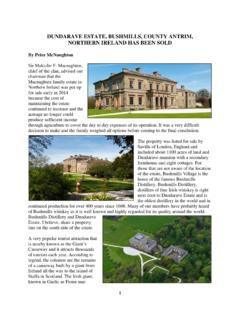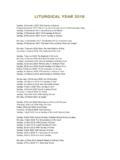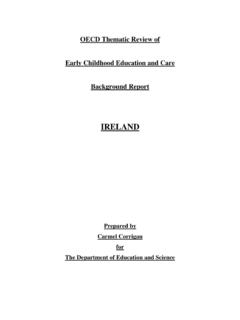Transcription of Ireland’s Economic Crisis The Good, the Bad and …
1 ireland s Economic Crisis The good , the Bad and the Ugly1 Karl Whelan University College Dublin June 18, 2013 Abstract: This paper provides an overview of ireland s macroeconomic performance over the past decade. In addition, to presenting the underlying facts about the boom, bust and (currently limited) recovery, the paper also discusses some common fallacies and misrepresentations of Economic events in ireland . The paper concludes with some broader lessons from the Irish experience for Eurozone Economic policy and some observations on the role that EMU and the ECB have played in ireland s Crisis . 1 Paper presented at Bank of Greece conference on the Euro Crisis , Athens May 24, 2013. 1 1. Introduction The turnaround in ireland s Economic fortunes in recent years is perhaps the most dramatic of any country in the euro area.
2 As recently as 2007, ireland was seen by many as top of the European class in its Economic achievements. A long period of high rates of Economic growth and low unemployment had been combined with budget surpluses. The country appeared well placed to cope with any Economic slowdown as it had a gross debt-GDP ratio in 2007 of 25% and a sovereign wealth fund worth about 5,000 a head. However, the subsequent crash involving a housing market collapse, soaring unemployment and a full-scale banking Crisis proved too difficult for the Irish government to manage on its own. In 2010, ireland agreed to an adjustment program with the EU and IMF. Today, ireland is poised to exit this program and, while Economic conditions remain poor and unemployment elevated, the country is again being cited regularly as an example for other countries in severe Economic difficulties.
3 Taken together, then, ireland s recent macroeconomic history provides interesting examples of both success (the good ..) and failure (the bad and ugly ..) within the Eurozone. Not surprisingly, events in ireland have commonly been used by in international debates among economists, politicians and international organizations to illustrate various preferred policy positions. However, often these arguments are based on a weak understanding of the underlying macroeconomic facts about ireland s economy. This paper provides an overview of ireland s macroeconomic performance over the past decade. In addition, to presenting the underlying facts about the boom, bust and (currently limited) recovery, the paper also discusses some common fallacies and misrepresentations of Economic events in ireland . The paper is organized as follows.
4 Section 2 focuses on the so-called Celtic Tiger boom, which occurred from the early 1990s through to 2007. It emphasizes that this period saw both good and bad developments. The important role played by cheap credit and lax banking regulation is highlighted as is the skewed construction-focused nature of the economy on the eve of the crash. However, it also stresses that much of the pre-crash growth in ireland was based on sound Economic fundamentals with steady improvements in productivity and employment accounting for most of the increase in output over this period. Sections 3 and 4 discuss ireland s crash, examining the popping of the housing bubble, its fiscal implications and the banking Crisis . In contrast to some discussions of this Crisis , I emphasize that ireland s huge build-up of debt was not predominantly due to its banking Crisis .
5 However, banking-related costs played a key role in making the debt burden appear unsustainable to financial markets and thus triggering an EU-IMF bailout. Section 5 of the paper discusses ireland s performance during the EU-IMF program and the economy s future prospects. It emphasizes that while ireland s relatively flexible labor market has helped it to perform better than some other Eurozone countries undergoing austerity, the austerity program has seen very few substantive structural reforms. Future Economic prospects are dampened by a serious debt hangover problem and the weak outlook for growth in Europe. Finally, Section 6 discusses some broader lessons from the Irish experience for Eurozone Economic policy and some observations on the role that EMU and the ECB have played in ireland s Crisis . 2 2. ireland s Economic Boom This section discusses ireland s long Economic boom that ended in 2007.
6 The first part focuses on the positive fundamental aspects of the Economic growth of this period while the second part describes the impact of the housing boom that dominated the later part of this expansion. The Celtic Tiger It is now well known that ireland s famed Celtic Tiger era ended with the collapse of a housing bubble and a banking Crisis . Many have thus been tempted to interpret the preceding boom as largely built on an unstable credit splurge. However, this would underestimate the true progress made by the Irish economy during the two decades prior to 2007. Before the Celtic Tiger became a well-known phrase during the 1990s, the Irish government had implemented a wide range of policies that helped to foster improvements in productivity. The 1960s saw a move away from protectionist trade policies and set ireland on the path to EU membership in 1973.
7 Industrial policies focused successfully on encouraging export-oriented foreign direct investment. There was also a gradual improvement in educational standards as policies to provide universal secondary education in the 1960s were subsequently followed by a large expansion of the third-level sector. As a result of these policies, Irish productivity growth consistently outpaced other advanced economies from the early 1970s onwards. By the mid-2000s, Irish labor productivity was very close to US levels (see Figure 1).2 While ireland s pre-Tiger supply-side policies may have been good ones, its macroeconomic stabilization policies were not always so good . ireland reacted to the global slowdown of the 1970s by running very large fiscal deficits, which cumulated in a debt Crisis in the 1980s. At the same time, the traditional currency link with sterling was dropped in 1979 in favor of membership of the European Monetary System, which provided an unstable monetary regime featuring regular devaluations.
8 By the mid-1980s, ireland had a public debt-GDP ratio over 110 percent and was paying out almost 10 percent of GDP per year in interest payments on this debt. Tax rates had been raised to punitive levels in a series of failed attempts to stabilize the deficit and growth had stagnated. It was at the depths of this previous Crisis that the birth of the Celtic Tiger took place. The period from 1987 onwards saw fiscal problems dealt with via a program that focused on restraining spending and by 1989, ireland s debt dynamics had clearly moved in direction of sustainability. At the same time, the EMS finally also delivered a period of monetary stability. With macroeconomic 2 These data come from the US Bureau of Labor Statistics International Comparisons website. One caveat worth noting is that ireland s low corporate tax regime has encouraged businesses to declare high profits in ireland , perhaps via mis-pricing of inputs via transfer pricing.
9 This pattern likely over-states the full extent of Irish GDP and thus of underlying productivity. However, even adjusting for this factor, productivity growth has been strong and room for catch-up is far lower than previously. 3 stability restored and good fundamental policies in place, the Irish economy began to grow at an impressive rate. Indeed, ireland in the late 1980s was primed for growth. While its workers were becoming increasingly productive, the population as whole was significantly under-employed. To explain this under-employment, the following decomposition is useful: Emp / Pop = (Work-Age / Pop)*(LForce / Work-Age)*(Emp/LForce) The ratio of employment to population is the ratio of work-age people to total population times the ratio of people in the labor force to the work-age population times the ratio of employment to the labor force. As Figure 2 shows, only about 30 percent of the population was at work in the late 1980s, an extremely low level by developed international standards.
10 This underemployment partly reflected an exceptionally high unemployment rate (Figure 3). However, it also reflected demographic and social factors that influenced the other elements of this ireland had a much delayed baby boom relative to the rest of Europe, one that started in the 1970s and peaked in the 1980s, so the depressed ireland of the 1980s was supporting a very large population below working age. This demographic pattern gradually unwound over time so that by the late 1990s, ireland had a higher fraction of its population in the working age bracket than either the US or the UK (see Figure 4). ireland in the late 1980s also had a very low rate of labor force participation: While female labor force participation had increased steadily in other countries throughout the 1960s and 1970s, this pattern was not replicated in ireland (see Figure 5). However, when the economy recovered, there was a large female labor supply ready to enter the workforce.











